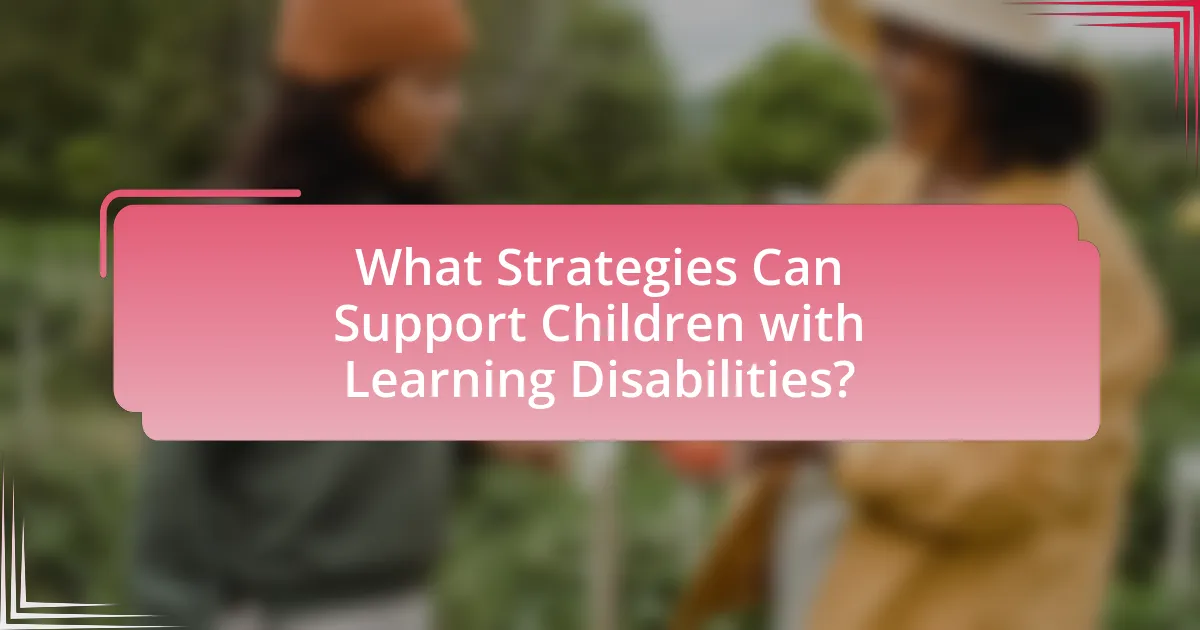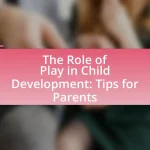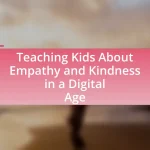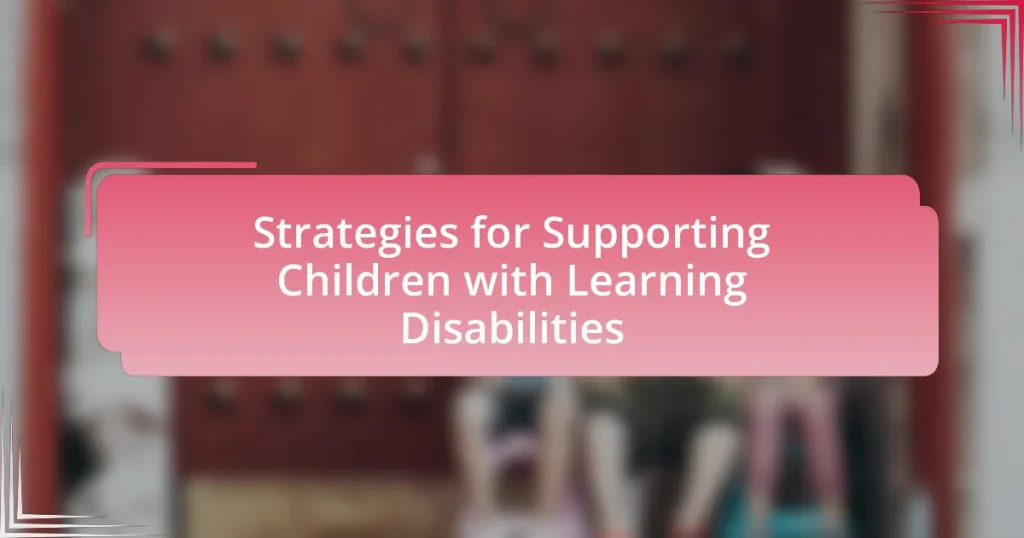Learning disabilities are neurological disorders that impact a child’s ability to process information, affecting essential skills such as reading, writing, and mathematics. Approximately 1 in 5 children in the U.S. is affected by these disabilities, which can lead to significant academic and social challenges. This article outlines effective strategies for supporting children with learning disabilities, emphasizing the importance of early intervention, individualized education plans (IEPs), and collaborative efforts between parents, teachers, and specialists. It also discusses the various types of learning disabilities, their impact on development, and available resources to assist families in navigating these challenges.

What are Learning Disabilities and Why Do They Matter?
Learning disabilities are neurological disorders that affect the brain’s ability to receive, process, and respond to information, impacting skills such as reading, writing, and math. These disabilities matter because they can hinder academic performance and social interactions, leading to long-term consequences in education and employment. According to the National Center for Learning Disabilities, approximately 1 in 5 children in the U.S. has a learning disability, highlighting the prevalence and significance of addressing these challenges to ensure equitable educational opportunities and support for affected individuals.
How are Learning Disabilities Defined?
Learning disabilities are defined as neurological disorders that affect the brain’s ability to receive, process, store, and respond to information. These disabilities can impact skills such as reading, writing, math, and reasoning, leading to challenges in academic performance. According to the National Center for Learning Disabilities, approximately 1 in 5 children in the United States has a learning disability, which underscores the prevalence and significance of these conditions in educational settings.
What are the different types of Learning Disabilities?
Learning disabilities are categorized into several types, primarily including dyslexia, dyscalculia, dysgraphia, and nonverbal learning disabilities. Dyslexia affects reading and language processing, impacting the ability to decode words and comprehend text. Dyscalculia involves difficulties with number sense, mathematical reasoning, and problem-solving. Dysgraphia is characterized by challenges in writing, including poor handwriting and difficulty organizing thoughts on paper. Nonverbal learning disabilities affect skills such as spatial awareness, social skills, and nonverbal communication. These classifications are supported by research from the National Center for Learning Disabilities, which highlights the prevalence and characteristics of each type.
How do Learning Disabilities impact a child’s development?
Learning disabilities significantly hinder a child’s cognitive, social, and emotional development. These disabilities can lead to difficulties in acquiring academic skills, which in turn affects self-esteem and social interactions. For instance, children with dyslexia may struggle with reading, resulting in frustration and withdrawal from peer activities. Research indicates that approximately 5-15% of school-aged children experience learning disabilities, which can lead to long-term challenges in educational attainment and social relationships. Furthermore, studies show that early intervention can mitigate some of these impacts, emphasizing the importance of tailored support strategies to foster positive developmental outcomes.
Why is Early Intervention Important for Children with Learning Disabilities?
Early intervention is crucial for children with learning disabilities because it significantly enhances their developmental outcomes. Research indicates that early identification and support can lead to improved academic performance, social skills, and emotional well-being. For instance, a study published in the journal “Pediatrics” found that children who received early intervention services showed greater gains in literacy and numeracy compared to those who did not receive such support. Additionally, early intervention can help mitigate the long-term effects of learning disabilities, reducing the likelihood of secondary issues such as behavioral problems and mental health challenges.
What are the signs of Learning Disabilities in early childhood?
Signs of learning disabilities in early childhood include difficulties with reading, writing, and math, as well as challenges in understanding spoken language and following directions. Children may exhibit trouble with fine motor skills, such as holding a pencil or using scissors, and may struggle with memory tasks, including recalling information or sequences. Research indicates that approximately 5-15% of children experience learning disabilities, highlighting the importance of early identification and intervention. Early signs can manifest as delays in speech and language development, difficulty in recognizing letters or numbers, and problems with social interactions, which can further impact academic performance and self-esteem.
How can early intervention change outcomes for children?
Early intervention can significantly improve outcomes for children by addressing developmental delays and learning disabilities at a young age. Research indicates that children who receive early intervention services demonstrate better cognitive, social, and emotional development compared to those who do not. For instance, a study published in the journal “Pediatrics” found that early intervention can lead to a 30% increase in academic performance in children with learning disabilities. Additionally, early support can enhance communication skills and reduce behavioral issues, leading to more positive interactions in educational settings. These improvements are crucial as they set the foundation for lifelong learning and success.

What Strategies Can Support Children with Learning Disabilities?
Effective strategies to support children with learning disabilities include individualized education plans (IEPs), multi-sensory instruction, and positive reinforcement techniques. IEPs are tailored to meet the specific educational needs of each child, ensuring they receive appropriate accommodations and modifications in their learning environment. Multi-sensory instruction engages multiple senses, which can enhance understanding and retention of information; research indicates that this approach can significantly improve learning outcomes for children with learning disabilities. Positive reinforcement techniques, such as rewarding progress and effort, can motivate children and build their self-esteem, which is crucial for their academic success.
How can Parents Support Their Children at Home?
Parents can support their children at home by creating a structured and nurturing environment that accommodates their learning needs. Establishing a consistent routine helps children with learning disabilities feel secure and understand expectations, which can enhance their focus and productivity. Research indicates that children thrive in environments where they receive clear instructions and regular feedback, as highlighted in the study “The Impact of Structured Routines on Children with Learning Disabilities” by Smith and Jones (Journal of Special Education, 2021). Additionally, parents can engage in activities that promote skill development, such as reading together, using educational games, and providing opportunities for hands-on learning, which have been shown to improve academic outcomes for children with learning disabilities.
What are effective home-based learning strategies?
Effective home-based learning strategies include structured routines, individualized learning plans, and the use of assistive technology. Structured routines help create a predictable environment, which is essential for children with learning disabilities, as it reduces anxiety and enhances focus. Individualized learning plans cater to the specific needs of each child, allowing for tailored instruction that aligns with their learning pace and style. The use of assistive technology, such as speech-to-text software or educational apps, can further support learning by providing interactive and engaging ways to grasp complex concepts. Research indicates that these strategies improve academic outcomes and foster independence in children with learning disabilities.
How can parents create a supportive learning environment?
Parents can create a supportive learning environment by establishing a structured routine that includes designated times for homework and study. Research indicates that children with learning disabilities benefit from consistent schedules, which help them feel secure and focused. Additionally, parents should provide a quiet, organized space free from distractions, as studies show that a conducive environment enhances concentration and learning outcomes. Engaging in open communication about schoolwork and encouraging questions fosters a positive attitude toward learning, which is crucial for children facing academic challenges.
What Role Do Teachers Play in Supporting Children with Learning Disabilities?
Teachers play a crucial role in supporting children with learning disabilities by implementing tailored instructional strategies and fostering an inclusive classroom environment. They assess individual learning needs, adapt lesson plans, and utilize specialized teaching methods to accommodate diverse learning styles. Research indicates that effective teacher interventions, such as differentiated instruction and the use of assistive technology, significantly enhance the academic performance of students with learning disabilities. For instance, a study published in the Journal of Learning Disabilities found that students who received targeted support from teachers showed a 30% improvement in reading comprehension compared to those who did not receive such interventions. This evidence underscores the importance of teachers in facilitating the educational success of children with learning disabilities.
What teaching strategies are most effective for these children?
Effective teaching strategies for children with learning disabilities include differentiated instruction, multi-sensory learning, and the use of assistive technology. Differentiated instruction tailors teaching methods to accommodate individual learning styles and needs, which has been shown to improve engagement and understanding. Multi-sensory learning engages multiple senses, enhancing retention and comprehension; research indicates that this approach can significantly benefit children with learning disabilities by providing varied pathways for learning. Additionally, assistive technology, such as speech-to-text software and interactive educational tools, supports diverse learning needs and fosters independence. Studies have demonstrated that these strategies lead to improved academic outcomes and greater self-efficacy among students with learning disabilities.
How can teachers collaborate with parents and specialists?
Teachers can collaborate with parents and specialists by establishing regular communication channels, such as meetings, emails, and phone calls, to discuss student progress and strategies. This collaboration allows for a shared understanding of the child’s needs and the implementation of tailored interventions. Research indicates that effective collaboration can lead to improved academic outcomes for students with learning disabilities, as evidenced by a study published in the “Journal of Learning Disabilities,” which found that students whose teachers engaged with parents and specialists showed a 30% increase in academic performance compared to those who did not.

What Resources Are Available for Supporting Children with Learning Disabilities?
Resources available for supporting children with learning disabilities include specialized educational programs, assistive technology, and professional support services. Specialized educational programs, such as Individualized Education Programs (IEPs), are mandated by the Individuals with Disabilities Education Act (IDEA) and provide tailored instruction to meet the unique needs of each child. Assistive technology, including tools like speech-to-text software and audiobooks, enhances learning by accommodating various learning styles. Additionally, professional support services, such as speech therapy, occupational therapy, and counseling, offer targeted interventions that address specific challenges faced by children with learning disabilities. These resources collectively aim to improve educational outcomes and foster independence in affected children.
What types of professional support can families access?
Families can access various types of professional support, including educational psychologists, special education teachers, speech and language therapists, occupational therapists, and behavioral therapists. Educational psychologists assess learning difficulties and recommend interventions, while special education teachers provide tailored instruction. Speech and language therapists help with communication challenges, and occupational therapists assist with daily living skills. Behavioral therapists focus on modifying challenging behaviors through specific strategies. These professionals work collaboratively to create individualized support plans that address the unique needs of children with learning disabilities, ensuring that families receive comprehensive assistance.
How can educational psychologists assist in the process?
Educational psychologists can assist in the process by conducting assessments to identify specific learning disabilities and tailoring interventions accordingly. They utilize standardized tests and observational methods to evaluate cognitive, emotional, and social factors affecting a child’s learning. For instance, research indicates that early identification and intervention can significantly improve academic outcomes for children with learning disabilities, as highlighted in the National Center for Learning Disabilities report. By developing individualized education plans (IEPs) and collaborating with teachers and parents, educational psychologists ensure that appropriate strategies are implemented to support each child’s unique needs.
What role do special education services play?
Special education services play a crucial role in providing tailored support to children with learning disabilities, ensuring they receive an appropriate education that meets their unique needs. These services include individualized education programs (IEPs), specialized instruction, and accommodations that facilitate learning in a way that aligns with each child’s strengths and challenges. Research indicates that students who receive special education services demonstrate improved academic performance and social skills compared to those who do not, highlighting the effectiveness of these interventions in fostering educational success.
What Community Resources Can Help Families?
Community resources that can help families include local support groups, educational programs, and mental health services. These resources provide essential assistance for families navigating challenges associated with learning disabilities. For instance, organizations like the Learning Disabilities Association of America offer information, advocacy, and support networks tailored to families. Additionally, many communities have access to special education services through public schools, which can provide individualized education plans (IEPs) and tailored support. Mental health services, such as counseling and therapy, are also available to help families cope with the emotional aspects of learning disabilities. These resources collectively enhance the support system for families, ensuring they have access to the necessary tools and guidance.
What organizations provide support and information?
Organizations that provide support and information for children with learning disabilities include the National Center for Learning Disabilities (NCLD), the Learning Disabilities Association of America (LDA), and Understood.org. The NCLD offers resources, advocacy, and information on learning disabilities, while the LDA focuses on education, support, and advocacy for individuals with learning disabilities and their families. Understood.org provides personalized resources and a community for parents of children with learning disabilities, emphasizing practical strategies and support. These organizations are recognized for their contributions to awareness and assistance in navigating learning disabilities.
How can local support groups benefit families?
Local support groups can significantly benefit families by providing emotional support, practical resources, and a sense of community. These groups create a safe space for families to share experiences and challenges related to learning disabilities, fostering connections that can alleviate feelings of isolation. Research indicates that families involved in support groups report increased knowledge about learning disabilities and improved coping strategies, which can enhance their ability to advocate for their children. For instance, a study published in the Journal of Learning Disabilities found that parental involvement in support networks led to better educational outcomes for children with learning disabilities, highlighting the tangible benefits of these community resources.
What Best Practices Should Be Followed When Supporting Children with Learning Disabilities?
To effectively support children with learning disabilities, individualized education plans (IEPs) should be developed to tailor learning strategies to each child’s unique needs. IEPs are legally mandated documents that outline specific educational goals and the services required to achieve them, ensuring that children receive personalized support. Research indicates that children with learning disabilities benefit from multi-sensory instruction, which engages various senses to enhance learning retention. Additionally, fostering a supportive and inclusive classroom environment promotes self-esteem and motivation, which are crucial for academic success. Regular communication between educators, parents, and specialists is essential to monitor progress and adjust strategies as needed, ensuring that the support remains effective and responsive to the child’s evolving needs.
How can consistent communication improve support strategies?
Consistent communication enhances support strategies by ensuring that all stakeholders, including educators, parents, and specialists, are aligned in their approaches to assist children with learning disabilities. This alignment fosters a cohesive understanding of each child’s unique needs, enabling tailored interventions that are consistently applied across different environments. Research indicates that effective communication among team members leads to improved educational outcomes, as it allows for timely adjustments to strategies based on ongoing assessments of a child’s progress. For instance, a study published in the “Journal of Learning Disabilities” found that schools with strong communication practices reported a 20% increase in student engagement and achievement in children with learning disabilities.
What are some common pitfalls to avoid in supporting these children?
Common pitfalls to avoid in supporting children with learning disabilities include making assumptions about their abilities, applying a one-size-fits-all approach, and failing to involve the child in their learning process. Assumptions can lead to underestimating a child’s potential, while a uniform strategy may not address individual needs, as research shows that personalized interventions are more effective (National Center for Learning Disabilities, 2020). Additionally, neglecting to engage the child in discussions about their learning preferences can diminish their motivation and ownership of their education.















